2019 marked the fourth summer of our intensive, community-engaged Nepali and Tibetan courses. Take a look below to see what happened!
To read about the Nepali language course, click here |
|
|
To read about the Tibetan language course, click here |
Program Overview
The UBC Himalaya Program has offered community-engaged Nepali and Tibetan language courses since 2016. The summer of 2019 was the second year in a row where a two-week, three-credit course offered a blended model of classroom learning and community engagement. This year’s courses ran daily between April 29th – May 10th, 2019, from 9:00am – 12:30pm, with some additional afternoon and evening activities.
To build upon classroom instruction with professors Mr. Binod Shrestha (Nepali) and Mr. Sonam Chusang (Tibetan), students were immersed in a series of community engagement activities which allowed them to practice their language skills and gain unique intercultural experiences. Both on and off campus, students learned from members of the Vancouver-based Tibetan and Nepali communities, creating a “study abroad at home” experience.
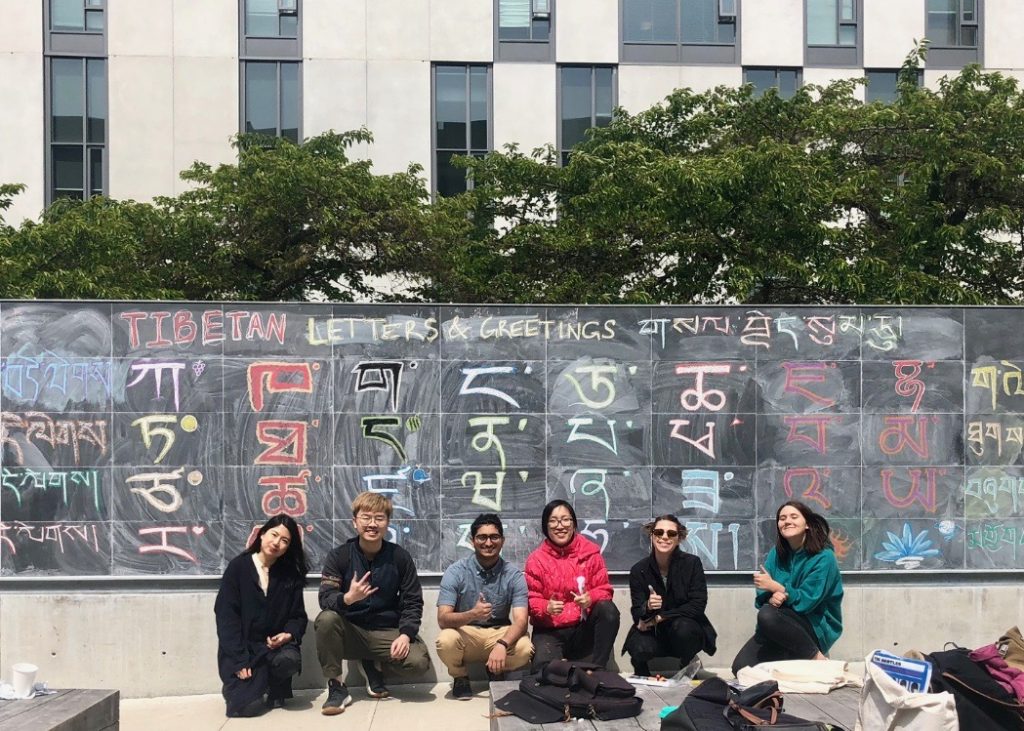 Tibetan language students practice script writing on a public chalkboard on UBC Vancouver campus |
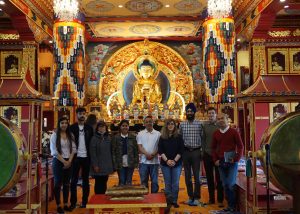 Nepali language students and Professor Binod Shrestha at Thrangu Monastery in Richmond |
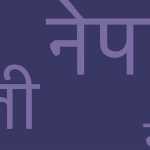
NEPALI 2019
Taught by Mr. Binod Shrestha.
Classroom Instruction
Classroom instruction incorporated lectures, in-class activities, role plays, and practice. Students learned grammar, pronunciation and script writing skills to engage in basic conversations and practical scenarios. 2019 was also the first summer where Nepali script writing (Devenagari) was taught in conjunction with romanized text. While students found it challenging, they also found it added depth and interest to the overall course.
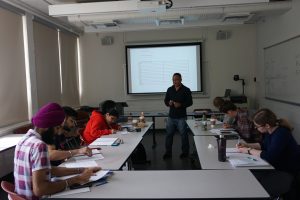 Professor Binod instructs the Nepali students |
Classroom Visits
Part of the community-engaged programming incorporated classroom visits from Nepali community members. For the first of these, guest speakers Dr. Mark Turin and Dr. Pasang Sherpa visited the Nepali class and spoke about their experiences working in Nepal, and discussed some of the intricacies of pronouns in the language. The speakers were very engaging and an excellent first taste of the community engaged learning to come.
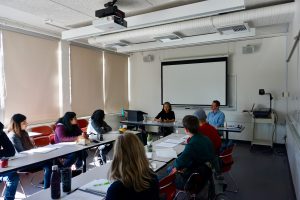
Pasang Sherpa and Mark Turin visit the Nepali class
The second classroom visit was by Sabita Shrestha. Sabita is an active member of the Nepali community in Vancouver, and was kind enough to share her love of music with the Nepali language students. She spoke about Nepali instruments and music styles, and taught the students a traditional folk song titled “Resham firiri.” Students learned the lyrics impressively quick and had the opportunity to perform the song two more times over the course of the 2-week program.
Off-Campus Visits
Students also had the opportunity to be immersed in Nepali culture off-campus. First, the students were welcomed by the Nepali Canadian Women’s Society of British Columbia (NCWSBC) where they practiced their language skills with a variety of native Nepali speakers, ate home-cooked Nepali food, and learned some Nepali dance steps.
“ The most rewarding part of the day was making connections with the Nepali community and learning new language skills, dance skills and knowledge about Nepal.”
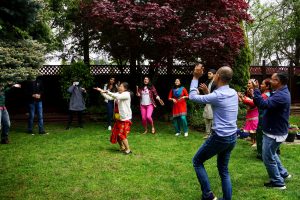
Students learn Nepali dance
Next, students visited Thrangu Monastery in Richmond, the first Tibetan Buddhist monastery in the Pacific Northwest, where many of the monks speak Nepali. The students participated in a prayer ceremony, followed by a tour of the monastery and a talk with Gen Tenzin, one of the monks. Later, the students were able to spractice their Nepali by asking the Nepali-speaking monks questions. It was a wonderful cross-cultural experience for the students and staff in attendance.
 Nepali students at Thrangu Monastery |
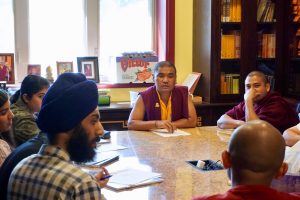 Nepali students speak with monks at Thrangu Monastery |
On the final day of the language course, Nepali students were invited by the Hindu Buddhist Foundation of Canada (HBFC) to visit their new community centre. More than 20 Nepali community members were there to speak with the students, share a delicious meal, and perform Nepali songs and dance, including the song they learned with Sabita Shrestha earlier that week.
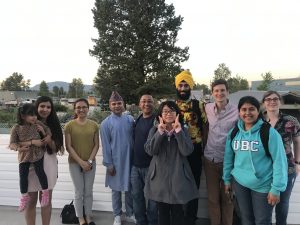
Nepali language students visit the HBFC
At the end of the course, the students reflected positively on the value that community engagement added to the language learning experience.
“I can’t believe that this was the last day! The course seemed to fly by… I did not expect to come so
far in so short a time.”
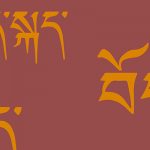 TIBETAN 2019
TIBETAN 2019
Taught by Mr. Sonam Chusang.
Classroom Instruction
The classroom component of the Tibetan language course covers similar subjects to those of the Nepali course. Students learned grammar, pronunciation and vocabulary appropriate for everyday communication. They also learned how to speak in an honorific tone, and write in Tibetan script. In-class activities and practice exercises were used to engage students in the learning experience.
Classroom Visits
The first guest speakers were Ama Dolma la and Pa Kalsang la, who visited to speak about their life story, and engage in conversation with students. They lived in Tibet for most of their lives, and their story inspired and touched the hearts of the Tibetan language students. One student summed up their experience with the two guests:
“They remind me that the communities of the world have much to learn from each other, and that everyone could learn about the nature of compassion from the Tibetan people”
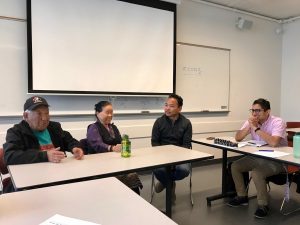
Ama Dolma and Pa Kelsang visit the Tibetan Language class
The second speaker was Geshe Tenzin La, who spoke about how to strengthen one’s motivation and overcome the habit of procrastination based on Tibetan Buddhist teachings. He offered some antidotes for laziness, which students found very helpful.
Off-Campus Visits
The first off-campus community visit was to Terra Breads. The café, which employees several Tibetan community members, welcomed the students and allowed them to practice ordering their food in Tibetan. The students then conversed with other locally resident native Tibetan speakers while they ate their lunch. This experience offered an opportunity for the students to put their language skills to practice and build connections with others.
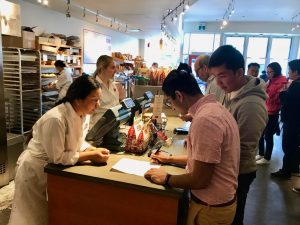 Tibetan students practice ordering food in Tibetan |
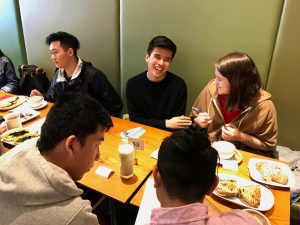 Students practice speaking in Tibetan at Terra Breads |
On the final day of the language program, the Tibetan language students visited Tsengdok Monastery in Vancouver, where they participated in a meditation, practiced speaking with the Tibetan monks, and learned how to make momos.
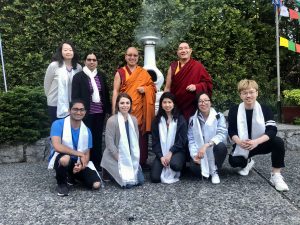
Tibetan students at Tsengdok Monestery
“Achieving something together brings everyone closer. Interacting with people with Tibetan background allowed me to connect what I have learnt with reality.”
Course Wrap-Up
On the final day of the courses, the Nepali and Tibetan students gathered with the Himalaya Program Steering Committee to share a meal and perform the songs they had learned. It was a meaningful way to complete the experience and share with fellow students.
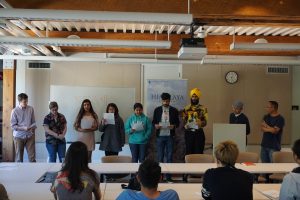 Nepali students perform a song |
 The Steering Committee, Nepali students and Tibetan students gather on the final day of classes |
 Tibetan students perform a song |
To receive up-to-date information about our courses and programs, please sign up for our mailing list.
These courses are supported by the UBC Faculty of Arts, the Teaching and Learning Enhancement Fund (TLEF), the Centre for Community Engaged Learning (CCEL), the School of Public Policy & Global Affairs / Institute of Asian Research, and the Department of Asian Studies.